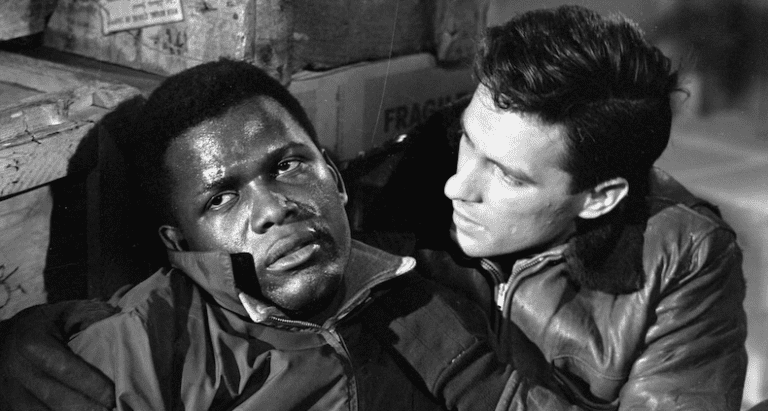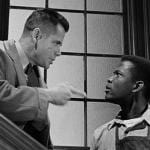The latest in a month-long series of re-posts from my Facebook marathon in April 2020.
–
Sidney Poitier marathon part 4 (1957):
Poitier’s big-screen career took a big leap forward in 1957, as the actor — who had never been in more than one movie per year before — suddenly found himself in four big-screen movies in a single year. And what a mix of movies they are. He played supporting roles opposite some fairly big movie stars, and he took leading roles in smaller films. He worked with directors at the very beginning of their careers, and he worked with directors who were near the end of their careers. He played reasonably happy characters, and he played very angry characters. He was in movies that took aim at the hypocrisy of western religion, and he was in movies that celebrated the triumph of western religion over pagan superstition.
The year began with Edge of the City (1957). The main character is a man with a secret, played by John Cassavetes, who gets a job as a longshoreman and is befriended by Poitier, a fellow longshoreman who helps Cassavetes find a place to live and a woman to date. Poitier’s character is defined by his sense of humour, and for the first hour or so the film is a reasonably upbeat depiction of an interracial friendship (how many films had done this at the time?). But things turn tragic when Cassavetes’ racist boss, played by Jack Warden, objects to their friendship and gets into a fight with Poitier.
I had never seen this movie before, but something about it seemed familiar to me… and then I realized that Robert Jewett devoted an entire chapter to this film in his 1999 book Saint Paul Returns to the Movies: Triumph over Shame. That book had a huge influence on my theological outlook at the time, and this was one of two films analyzed in that book that I had never seen at the time. Well, it took me a while, but I have finally taken care of that gap in my film literacy.
Poitier is very good in this film, but it’s really Cassavetes’ story, and the Poitier character’s death is ultimately a catalyst for character growth on Cassavetes’ part. That makes this the first film in which Poitier becomes a Christ-figure of sorts (which is one of the reasons the film figures so prominently in Jewett’s book), but it also leaves the film open to the charge that it’s one of those movies in which a minority-identified person dies so that a majority-identified person can benefit somehow. (Was this already a cliche then, though? Or did it become one later?) Still, Poitier is so good in the role — the film is so clearly interested in his character for his own sake — that the film transcends those concerns, I think.
A few other quick points about this film:
— It was the first movie to be directed by Martin Ritt, who went on to make 1963’s Hud, 1970’s The Molly Maguires and 1979’s Norma Rae. Cassavetes would soon direct his own first film, 1958’s Shadows, just one year later.
— Poitier would go on to work with Ritt and Cassavetes again. This film also marks the third time he worked with Ruby Dee, following 1950’s No Way Out and 1954’s Go Man Go; they would go on to make three more films together.
— Edge of the City was a remake of a teleplay that Poitier had starred in two years earlier, and Poitier was the only actor who appeared in both versions of the story. The 1955 teleplay was Poitier’s last TV gig until the 1990s; his big-screen career would keep him busy for the next few decades.
The three films that followed all have lower profiles now, but are interesting in their own ways.
Something of Value (1957) stars Poitier and Rock Hudson as a black tribesman and a white farmer who grew up together as friends but now find themselves on opposite sides of the Mau Mau uprising, which began in 1952 and had not quite ended yet when this film came out (though the main leader of the uprising was captured and executed just a few months before the film’s release).
This film is remarkably ambivalent about the effect of British colonialism in Africa. Some of the white characters openly ask what good it does to ban tribal dances and female circumcision (!) if the Africans aren’t given something else — something of value, as the title puts it — that can replace the old religion and the traditions that went with it. When Poitier’s father has Poitier’s newborn son smothered to death for being “cursed” — i.e. for being born feet first — the British put Poitier’s father on trial for murder, and this becomes just one more example of the cultural insensitivity that drives Poitier to turn against Hudson and his fellow whites. (Poitier’s puzzled father explains to the court that, as far as his culture is concerned, it’s not “murder” if the child is not yet one year old.)
The film ends on a tragic note, as Poitier, who now has another newborn son, falls into a Mau Mau trap during a scuffle with Hudson. With his dying breath, Poitier asks Hudson to bury him with his son, but Hudson declines, opting instead to raise Poitier’s son alongside his own son, in the hope that the next generation will find the redemption that eluded his own generation. And I have to say, this is a striking note to end the film on, given that it was white attempts to rescue black babies from their (grand)parents that had sparked the narrative conflict in the first place.
And yes, this is the second film in a row in which the Poitier character dies tragically, leaving the white protagonist to learn from Poitier’s death and/or to hope for a better future.
A few other quick points about this film:
— It was the second of two films that Poitier made with director Richard Brooks, who had previously directed him in 1955’s Blackboard Jungle.
— Poitier is clearly a supporting actor here, but one sign that Poitier’s star was on the rise is that he gets one of those prominent “and so-and-so” credits at the end of the opening credits.
— The “intellectual leader” of the Mau Maus is played by William Marshall, who would go on to play the computer scientist Richard Daystrom in a 1968 episode of Star Trek; he then went on to star in 1972’s Blacula and its 1973 sequel. The Mau Mau “oath giver” is played by Juano Hernández, who went on to play a Christian minister opposite Poitier in 1957’s The Mark of the Hawk. And Rock Hudson’s fiancee is played by Dana Wynter, of 1956’s Invasion of the Body Snatchers.
— Some of the British characters are quite willing to accommodate the “witchcraft” of certain African tribal customs if they can find a scientific explanation for those customs, e.g. the practice of finding a liar from a line-up of suspects by applying a hot sword to each man’s tongue; the Brit explains that the liar’s mouth dries up from nervousness, so he reacts to the heat in a way the others don’t. I’m wondering now if this is an actual Kenyan practice or if it was made up by the writers.
— The image of an angry Poitier throwing an empty rifle at a white racist and then shooting him dead with a handgun, all while holding a baby in his other hand, is quite striking if you’re mainly familiar with Poitier from his later good-role-model roles.
Next up: Band of Angels (1957), starring Yvonne De Carlo as a Southern belle who learns, after her father dies, that her mother was a slave and therefore she is legally a slave too. After a horrifying interlude in which a slave trader comes thisclose to raping her, she is bought at an auction by Clark Gable, who proceeds to woo her as historical events intercede.
That’s right, it’s another Civil War movie starring Clark Gable; like 1939’s Gone with the Wind, it even has music by Max Steiner! Poitier plays a black man who works for Gable and seems friendly enough at first, but about half-way through the movie he reveals that he hates Gable for being so kind to him (at least when a man uses a whip, you know what to fight against, says Poitier). Poitier also objects to the way De Carlo can pass for white and the way she tries to resume her old life.
One of the recurring motifs of this film is that it doesn’t matter how nice a master or slave-owner appears to be, the mere fact that they operate within a slave-owning system means that abuse is always just around the corner. De Carlo’s father was a super-nice master who never sold any of his slaves to anyone, but the moment he died, all of his slaves were treated as mere property to be sold off to pay his debts — and that included De Carlo herself, once it was revealed who and what her mother was. Similarly, Gable is depicted as a super-nice master — his slaves literally greet him with song when he comes home — but he eventually reveals that he was once a slave trader who was just as nasty as any of them, and he says he’s been trying to make up for it ever since.
The big plot twist at the end comes when Gable reveals that Poitier is actually his son, and that it was the murder of Poitier’s mother — by a native African who had supplied Gable with slaves — that prompted Gable to quit the slave trade. So, just as De Carlo learned she was the daughter of a black mother, so too Poitier learns that he is the son of a white father. And this paves the way for all three to be reconciled.
A few other quick points about this film:
— This was one of the last films directed by Raoul Walsh, who had been directing movies since 1913. As an actor, he had also played John Wilkes Booth in D.W. Griffith’s 1915 film The Birth of a Nation, which gives this Civil War movie another interesting connection to Civil War movies of the past.
— This is the first Poitier film to be shot in colour, rather than black and white.
— While the film is critical of slavery, even the “good” kind, it is also very negative in its depiction of at least some aspects of the anti-slavery forces. One of De Carlo’s beaus — before she learns she is part-black — is an abolitionist preacher who is involved with Abraham Lincoln’s election campaign and objects to forms of music that can excite “baser desires”. When he meets De Carlo again several years later, he says he was a fool to be so uptight… and he promptly tries to molest her or worse, which causes her to flee and denounce him as a “hypocrite”. Meanwhile, Gable says the Union Army has no interest in liberating slaves but is planning on “confiscating” them instead and sending them to “carpetbagging plantations” where they will be beaten but receive no wages.
— Gable goes on to say, “If we could live another hundred years, we’d probably see white justice for blacks…” This scene is set in 1865, and the film was made in 1957. Do the math.
— Wikipedia says Poitier had difficulty getting ahead in black theatre groups at the start of his career because, “contrary to what was expected of black actors at the time, Poitier’s tone deafness made him unable to sing.” There is a scene in this film in which Gable asks Poitier to sing a sea shanty, and Poitier obliges… and it is so, so obvious that Poitier is being dubbed.
Finally: The Mark of the Hawk (1957), which casts Poitier as a politician newly elected to a position within a colonial African government. Poitier is working for change from within the system, but his brother is part of a revolutionary group and accuses Poitier of being an “Uncle Tom” — and of course, the authorities are suspicious of Poitier because of his brother’s activities.
In sharp contrast to Something of Value, which was skeptical of British colonialism, and Band of Angels, which was skeptical of Christian abolitionists, The Mark of the Hawk is so boldly positive in its treatment of Christian missionaries that I wonder who really produced it. It was the only feature film directed by Michael Audley, who spent most of his career as a dialogue coach and has a writing credit on 1961’s Constantine and the Cross; and it was the only feature film written by Lloyd Young or H. Kenn Carmichael, though the two writers did collaborate on a short film called The Saint of Devil’s Island which was also released under the name Seventy Times Seven.
Anyway. Juano Hernández, the Afro-Puerto Rican actor who played the pagan “oath giver” in Something of Value, here plays a Christian minister who gives a robust defense of the church and its influence in Africa, saying it brought medicine and a belief in the equality of races, among other things.
A white American missionary also comes along to remind the other white characters that Christianity was once revolutionary itself, and he says it’s unfortunate that Christianity is now considered a defender of the status quo. He also talks about how he doesn’t want the church to make the same mistakes in Africa that it made in China, where it was recently expelled.
And, along the way, it is this white missionary who dies to effect a change in Poitier’s heart, which is a reversal of what happened between Poitier and the main white character in Edge of the City.
Two other quick points:
— This film was shot partly in Nigeria, and apparently it was shot there before Universal stepped in to become the film’s distributor. Again I wonder: who initiated production of this film?
— This is the second Poitier film to be shot in colour.
— Poitier’s wife is played by Eartha Kitt. It was the only film they made together.
— Were the producers unsure as to how quickly Poitier’s star was rising? He gets fourth billing in the opening credits but second billing in the closing credits. (Kitt comes first in both cases.)
–
The image above shows Sidney Poitier and John Cassavetes in Edge of the City.














